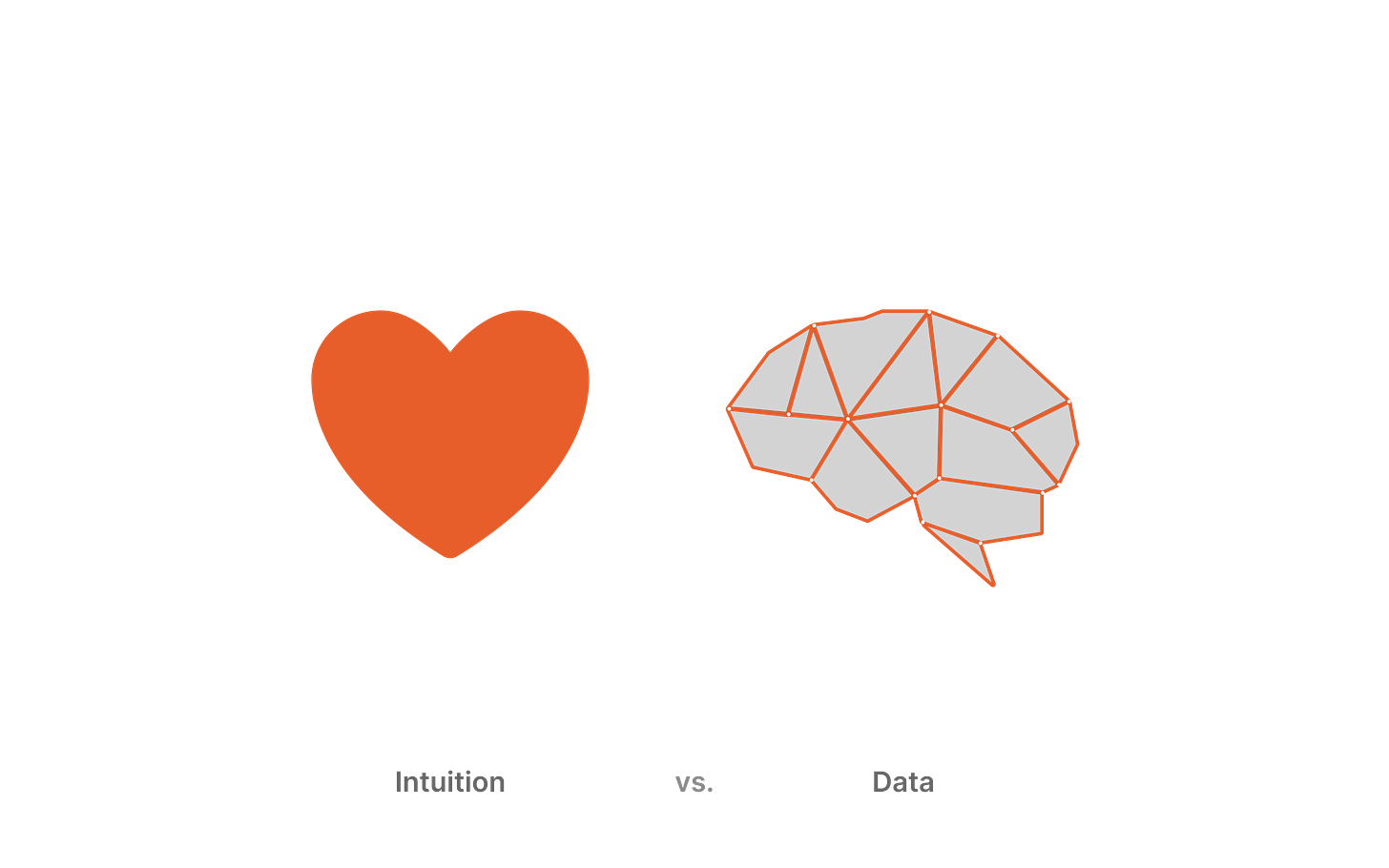Intuition vs. Data in product design
134: While some designers rely on their intuition and "gut feeling", others advocate for data-driven approach. But what if the secret lies in finding a balance between the two?

We all know that product design is not merely about aesthetics; it's about creating experiences that resonate with users on a profound level. It's about capturing their attention, igniting their emotions, and providing solutions that make their lives easier and more enjoyable.
Within the field of product design, there has been an ongoing debate surrounding the use of intuition vs. data-driven approaches. While some designers rely heavily on their intuition and creative instincts, others advocate for a more data-driven and analytical approach. But what if the secret lies in finding a delicate balance between the two?
Understanding intuition in design
Understanding intuition in design goes beyond relying on logic and reasoning. It taps into a deeper understanding from years of experience and an intrinsic ability to connect with users. Intuition is the silent voice that guides us, nudging us toward design choices that "feel right."
It allows us to step into the shoes of the user, empathize with their struggles, and create solutions that go beyond what the numbers can tell us.
Intuition empowers us to anticipate user needs, identify pain points, and envision solutions that surpass traditional data analysis. It enables us to craft intuitive and seamless user experiences that resonate with our target audience.
By tapping into our intuition, we can unleash our creative potential and push the boundaries of what is possible in design.
The power of data in design
On the other hand, the power of data in design cannot be underestimated. Data-driven insights provide valuable information about user behavior, preferences, and patterns. It allows us to make informed decisions based on evidence rather than assumptions. Analyzing user data enables designers to uncover trends, identify pain points, and optimize our designs to meet user needs more effectively.
This data-driven approach allows us to identify pain points, prioritize features, and make informed design decisions. It empowers us to create products that are not only visually appealing but also highly functional and tailored to the specific needs of our users.
Data acts as a compass, guiding us toward evidence-based design choices that are more likely to succeed.
The limitations of intuition and data in isolation
However, relying solely on intuition can lead to subjective biases and assumptions that may not align with the needs and expectations of users.
Our personal experiences and biases can dim our judgment, preventing us from seeing the bigger picture. It is crucial to recognize the limitations of our perspectives and complement our intuition with objective data. By doing so, we can validate our design choices and ensure they resonate with a broader audience.
On the other hand, solely relying on data-driven insights can result in designs that lack the human touch. Data can tell us what users want, but it may not capture the emotional aspects of user interaction.
It may miss the intangible elements that genuinely engage and delight users. Design is not just about meeting functional needs; it's about creating experiences that evoke positive emotions and build lasting connections with users.
Finding the balance: integrating intuition and data
We must embrace a holistic approach to find the balance between intuition and data. We start with intuition as our guide, allowing it to shape our initial design concepts and ignite the creative ideation process.
It sparks our imagination and encourages us to think outside the box. Intuition acts as a catalyst for innovation, enabling us to envision groundbreaking solutions that resonate with users on a deep level.
However, intuition alone is not enough. We must validate and refine our intuitive decisions with data-driven insights. User research, usability testing, and A/B testing become our allies, providing us with crucial feedback and validation.
By incorporating data into our design process, we can ensure that our choices align with user needs and expectations. It helps us bridge the gap between intuition and real-world effectiveness.
Real-world examples
Real-world examples highlight the power of integrating intuition and data in design. Take Apple's iPhone, for instance. Its iconic design emerged from Steve Jobs' intuitive vision for a touch-based interface that revolutionized the smartphone industry. However, its success was further bolstered by rigorous usability testing and user feedback, ensuring that the design choices aligned with user expectations.
Similarly, Airbnb combines intuitive design choices that foster a sense of belonging and exploration with data-driven personalization and recommendations. By leveraging user data, they create a highly engaging user experience that captivates users worldwide. Integrating intuition and data has been instrumental in shaping these successful designs.
In conclusion, the debate between intuition and data in product design is ongoing. Still, the true magic happens when these two forces collaborate harmoniously.
By embracing a balanced approach that allows intuition to inspire creativity and innovation while leveraging data to validate and optimize our design choices, we can create user experiences that are both intuitive and data-informed.
Through this integration, we unlock the power to captivate and delight users, leaving a lasting impact in the world of digital product design.
